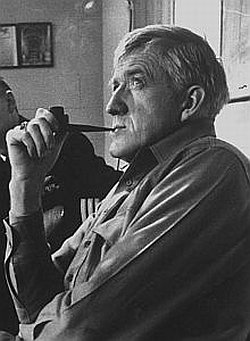 STRONG, John D. (1905 - 1992)
STRONG, John D. (1905 - 1992)

Was a scientist and inventor, famous by discovering water vapor on Venus atmosphere through spectroscopy. As a researcher and educator, Dr. Strong contributed significantly to technology in physics, astronomy, meteorology and optics.
Born in Riverdale. Kansas, on January 15, 1905, Strong received degrees from the University of Kansas (BA 1926) and the University of Michigan (M.S., 1928, Ph.D., 1930). After twelve years at CalTech and wartime research at Harvard on infrared systems, Strong became professor and director of the Astrophysical and Physical Meteorology Laboratories at Johns Hopkins University in 1946.
In middle 50's he was contacted by the Office of Naval Research (ONR), whom asked for a scientifical project to include onboard one of the manned flights under program STRATOLAB. He decided to focus the task on infrared planetary observations and designed a Schmidt telescope with a 16-inch diameter mirror, an auxiliary small telescope of 3-inches for fine tracking developed by Librascope, and a spectrograph as main instrument.
Initially he was offered to co-pilot the flight along with Malcolm D. Ross in 1958, but just before launch the balloon ripped open from top to bottom. Although both agreed to use a spare balloon, Navy officials decided not to risk a failure and wait until further investigation of the issue. As a result, the flight was postponed for the next year, and finally the co-pilot for Stratolab-High IV was Charles Moore. The mission was very succesfull as was detected the presence of water vapour in the atmosphere of Venus for the first time. Strong, published his findings in a paper in 1964, but other experts disputed his claim and insisted that Venus's clouds were only volcanic dust.
Strong developed furthermore the guidance system used in the Stratolab telescope and developed at John Hopkins University, an unmanned gondola for astronomical observation called "Ball-Ast" which made some succesfull flights during 1964 and 1965. These missions finally aported harder evidence of their initial findings on Venus atmosphere.
In 1967 he left John Hopkins to become professor at the University of Massachusetts in Amherst, remaining there until 1975.
Besides his incursion in the ballooning field, throughout his career he made several contributions to optics in spectroscopy including the coating technique that remains in wide use today in telescopes and other devices as well in computer chips. He also developed anti-reflective coatings for optical elements to prevent spurious "ghost" images, and made major advances in defraction gratings.
Strong published hundreds of papers and wrote several textbooks, including "Procedures in Experimental Physics", "Concepts of Classical Optics" and "Procedures in Applied Optics". He won medals from the Society of Photo-Optical Instrument Engineers, the Franklin Institute and the Optical Society of America, of which he was president.
He died on March 28, 1992 at a Nursing Home in Amherst, Massachussetts. He was 87 years old.

